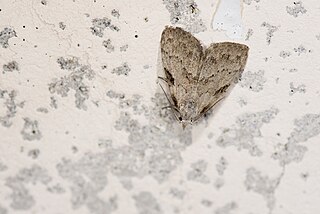
Condicinae is a subfamily of moths in the family Noctuidae. The subfamily was erected by Robert W. Poole in 1995.

Manoba is a genus of moths in the family Nolidae. The genus was first described by Francis Walker in 1863.

Oreta is a genus of moths belonging to the subfamily Drepaninae. The genus was erected by Francis Walker in 1855.
Meganola brunellus is a moth of the family Nolidae. It is found in Sri Lanka, India, Taiwan, Japan, the Ryukyu Islands, Sundaland, Queensland and the Bismarck Islands. It is an introduced species in Hawaii.
Manoba albina is a moth in the family Nolidae. It was described by Rothschild in 1912. It is found in New Guinea.
Manoba albiplagiata is a moth in the family Nolidae. It was described by Rothschild in 1912. It is found in New Guinea.
Manoba munda is a moth in the family Nolidae. It was described by Joseph de Joannis in 1928. It is found in Vietnam.
Stictane obscura is a moth in the subfamily Arctiinae. It was described by Hiroshi Inoue in 1976. It is found in Japan.
Manoba terminalis is a moth in the family Nolidae. It was described by Rothschild in 1912. It is found in New Guinea.
Manoba argentaloides is a moth in the family Nolidae. It was described by Jeremy Daniel Holloway in 2003. It is found on Borneo and possibly Seram. The habitat consists of upper montane forests.
Manoba chamberlaini is a moth in the family Nolidae. It was described by Jeremy Daniel Holloway in 2003. It is found on Borneo and in Thailand. The habitat consists of upper montane forests.
Manoba coxi is a moth in the family Nolidae. It was described by Jeremy Daniel Holloway in 2003. It is found on Borneo and Thailand.
Manoba fasciatus is a moth in the family Nolidae. It was described by George Hampson in 1894. It is found in the Indian states of Sikkim and Assam, and in Thailand and Japan.
Manoba lativittata is a moth in the family Nolidae. It was described by Frederic Moore in 1888. It is found in Sikkim state of India and in Thailand.
Manoba lilliptiana is a moth in the family Nolidae. It was described by Hiroshi Inoue in 1998. It is found in Nepal and Thailand.
Manoba melanomedia is a moth in the family Nolidae. It was described by Hiroshi Inoue in 1991. It is found on Borneo and in Taiwan and Thailand. The habitat consists of hill dipterocarp forests and lower montane forests and scrub on limestone.
Manoba melanota is a moth in the family Nolidae. It was described by George Hampson in 1900. It is found in Nepal, India and Thailand.
Manoba subfuscataria is a moth in the family Nolidae. It was described by Hiroshi Inoue in 1998. It is found in Nepal and Thailand.
Manoba suffusata is a moth in the family Nolidae. It was described by Wileman and West in 1929. It is found in Taiwan, Thailand, Vietnam and Myanmar, as well as on Sumatra and Borneo. The habitat consists of alluvial forests, wet heath forests, lowland forests, gardens and secondary forests.

Manoba tesselata is a moth in the family Nolidae. It was described by George Hampson in 1896. It is found in Taiwan, as well as on Borneo, Sumatra, Java, Bali, Seram and the north-eastern Himalayas and in Thailand. The habitat consists of montane forests.



